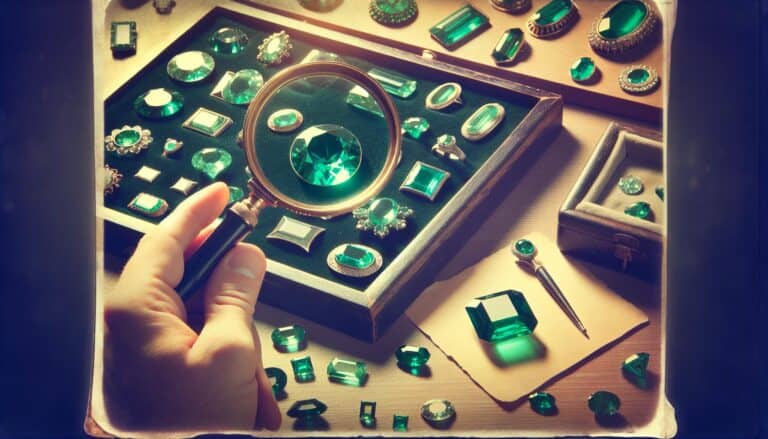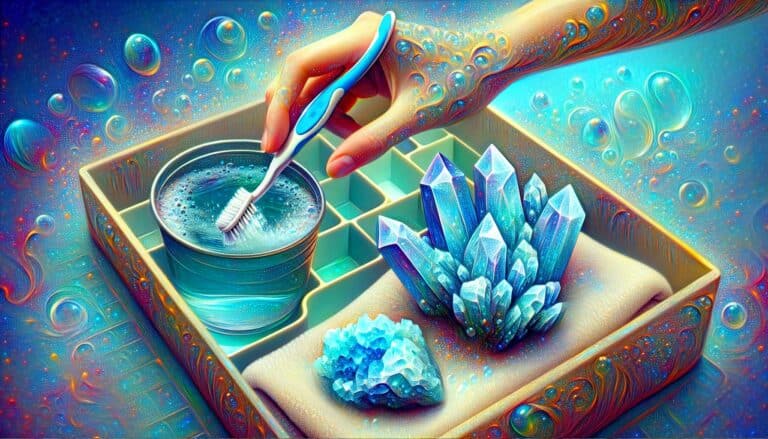Discovering the rich, cinnamon hues of hessonite garnet can be like uncovering hidden treasure.
This unique gemstone, often called the “cinnamon stone,” is not only stunning but also brimming with history and lore.
You’re about to learn how to distinguish genuine hessonite garnet from its counterparts. With its distinct characteristics and charm, knowing what to look for ensures you’re getting the real deal.
Let’s delve into the world of gemstones and unlock the secrets to identifying hessonite garnet.
To identify hessonite garnet, look for its unique cinnamon color and wavy ‘treacle’ effect. Perform a streak test for a white streak, check for slight magnetic response, and measure hardness (6.5-7.5 on Mohs scale). Observe birefringence using a polariscope and check the refractive index (1.74-1.75).
How to Identify hessonite garnet Through Testing
As you delve into the world of gemstones, identifying genuine hessonite garnet becomes a valuable skill. Understanding testing methods will ensure you’re equipped to spot the real deal.
Visual Inspection
Begin with a thorough visual inspection of the stone. Look for the trademark honey or cinnamon color. Hessonite garnet possesses a unique ‘treacle’ effect distinguishable by its wavy, uneven patterns within the stone.
The Streak Test
Drag the gem across a piece of unglazed porcelain and examine the streak color. Unlike other garnets that leave a red streak, hessonite generally leaves a white streak, indicative of its authenticity.
Magnet Test
Performing a magnet test can be useful. Hessonite garnet contains iron and may show a slight magnetic response. However, it’s less magnetic than other iron-rich stones, so the reaction might be subtle.
Hardness Test
With a Mohs scale of hardness, you’ll find hessonite ranks around 6.5 to 7.5. Test its resistance against scratches by using a tool or another gem with a known hardness.
Birefringence Test
Birefringence is a characteristic of hessonite garnet. Using a polariscope, you should spot a double image when viewing the stone through the eyepiece, indicating a level of birefringence.
Checking The Diaphaneity
Examine the diaphaneity or transparency of the garnet. Hessonite ranges from transparent to translucent, with cloudiness being a telltale sign due to its high number of inclusions.
Single or Double Refraction
Hessonite is singly refractive, unlike synthetic counterparts which often exhibit double refraction. Testing refraction can be done with a refractometer or by simply looking at lettering through the gem.
Refractive Index Test
Using a refractometer, you can measure the refractive index of hessonite which typically ranges between 1.74 and 1.75. This test offers concrete evidence of the gemstone’s identity.
Finding The Specific Gravity
The specific gravity for hessonite garnet varies from 3.55 to 3.6. Distinguishing by specific gravity involves a hydrostatic balance or a special liquid kit designed for gemstone testing.
Identifying Hessonite Garnets in the Field
If you find yourself in the field, identify potential hessonite garnet locations by researching previous gemstone findings. Look for characteristics like specific gravity and color saturation.
Recognizing Potential Hessonite Garnet Rocks
In mineral-rich environments, hessonite garnet often forms in metamorphic rocks. Scout for rocks that show potential, looking for the cinnamon color and crystal formations typical of hessonite.
Armed with these tests, you’re on your way to becoming adept in identifying genuine hessonite garnet. Each test reveals unique attributes, helping you discern real hessonite from the plethora of other gemstones on the market.
Physical Characteristics of hessonite garnets

When you’re on the hunt for hessonite garnets, knowing the key physical traits can lead you straight to the real thing. Hessonite, a variety of grossular garnet, is renowned for its cinnamon to reddish-orange hues. Occasionally, you’ll find specimens in shades of pink or brown, but that warm, spicy color is your first clue.
Dive into the texture and you’ll notice that hessonite has a signature turbid or ‘treacly’ appearance, often described as resembling honey. Unlike other gemstones that boast a crystal clear composition, a hessonite’s inclusions create a blurry, swirling visual that’s quite unique.
Size can also be indicative. Generally, hessonites are found in smaller sizes, with larger, high-quality gems being a rare find.
Specific Measurements
But don’t just rely on appearance alone. Equip yourself with some precision tools and get measuring. Hessonite garnets possess a specific range of hardness on the Mohs scale, typically between 6.5 and 7.5. Here’s a quick reference:
| Property | Measurement |
|---|---|
| Hardness | 6.5 to 7.5 Mohs |
| Refractive Index | 1.74 – 1.75 |
| Specific Gravity | 3.65 |
These numbers aren’t just statistics. They clue you in on the durability, optics, and density of the gemstone you’re examining. The refractive index reveals how light bends as it passes through the hessonite, while the specific gravity tells you how much heavier the gemstone is compared to water.
Remember, gemstones are all about specifics. Notice the details, measure accurately, and you’ll soon distinguish a genuine hessonite garnet from its many look-alikes.
How Are hessonite garnet Formed?
Hessonite garnets owe their existence to complex geological processes. Metamorphism and magma formation play pivotal roles in creating the unique characteristics you see in these stones. During the metamorphic process, rocks already present in the Earth’s crust undergo transformation due to intense heat and pressure. It’s these conditions that allow for the creation of garnet minerals, including hessonite.
Despite the variety of garnet types, hessonite garnets are particularly associated with limestone and other calcareous rocks. When these rocks come in contact with high-temperature fluids that are rich in silicates, garnets begin to form. The key element leading to the distinctive cinnamon orange hue of hessonite is the presence of manganese and iron.
- Limestone interaction with silicate-rich fluids is crucial for hessonite development.
- Manganese and iron concentrations contribute to the color.
Geologists look at specific environments known as contact metamorphic auras where these garnets are often found. You’d likely find hessonite garnets in regions where there have been substantial tectonic movements, which create the extreme conditions necessary for their formation.
Understanding the genesis of hessonite garnets arms you with the knowledge to better assess the stone’s authenticity. Geographical origins also add to the credibility of a hessonite garnet—regions like Sri Lanka and India are renowned for producing high-quality specimens. Keep in mind that the “where” is just as significant as the “how” when pinpointing these gemstones.
Preparation for hessonite garnet Hunting
As you gear up for hessonite garnet hunting, it’s crucial to have the right tools and prioritize safety. This preparation not only enhances the odds of a successful hunt but also ensures that you can handle and assess the gemstones directly in the field.
Gathering the Right Tools
To maximize your hessonite garnet hunting experience, arm yourself with specialized equipment designed for gemstone exploration.
- Geologist’s hammer: Essential for carefully extracting gemstones from surrounding rock.
- Chisels and picks: To delicately separate garnet crystals from their host minerals.
- Safety glasses: To protect your eyes from flying debris during extraction.
- Magnifying glass or jeweler’s loupe: For close examination of potential finds.
- Field guidebooks: To help you identify and compare hessonite garnet characteristics.
- Tweezers or forceps: For handling small garnets without causing damage.
- Streak plate: Useful for performing streak tests on site.
- Test kit for hardness: To quickly check if the stone matches the known hardness of hessonite garnets.
- Electronic scale: For measuring specific gravity accurately in grams per cubic centimeter.
- Notebook and pen: To log the details of your findings for future reference.
Bringing along these tools will greatly aid in the identification process, allowing you to conduct preliminary tests on potential garnet samples.
Safety Considerations
Safety should never be an afterthought when planning for hessonite garnet hunting. Here’s how to ensure you’re well-prepared:
- Wear sturdy gloves: To protect your hands from sharp tools and rough terrain.
- Durable boots: With slip-resistant soles for stability on uneven ground.
- Long-sleeved shirts and pants: Preferably made from robust material to shield against abrasions.
- First aid kit: Ready for any minor injuries that may occur.
- Sunscreen and insect repellent: Vital for outdoor protection.
- Sufficient water and food supplies: To maintain hydration and energy levels during long hours of hunting.
- GPS or a detailed map: To prevent getting lost in remote hunting areas.
- Communication device: Ensure it’s fully charged for emergency calls.
By paying attention to these safety measures, you’ll be equipped to focus on the exciting task of uncovering these semi-precious stones while minimizing risks to your health and safety. Keep mindful of your surroundings and be prepared to handle the rugged conditions often associated with gemstone hunting locations.
Handling and Care of Found hessonite garnets

Once you’ve successfully located hessonite garnets, proper handling and care are crucial to maintain their beauty and value. Here’s what you need to know to keep your garnets in pristine condition.
Cleaning Hessonite Garnets
Your hessonite garnets will likely need cleaning after being unearthed. Begin with a soft brush to remove loose dirt. For a deeper clean:
- Use warm soapy water to soak the gemstones.
- Gently scrub with a soft-bristled toothbrush to dislodge any remaining grit.
- Rinse thoroughly with distilled water to avoid water spots.
Avoid harsh chemical cleaners or ultrasonic cleaners, as these can damage the garnets.
Storing Hessonite Garnets
Proper storage of your hessonite garnets is critical to prevent scratches and chips. Follow these guidelines:
- Wrap each garnet in a soft cloth or place it in a fabric-lined box.
- Ensure garnets are stored separately to avoid abrasion.
- Keep them in a cool, dry place out of direct sunlight to prevent fading.
By adhering to these cleaning and storage protocols, your hessonite garnets will retain their luster and allure for years to come. Remember to handle these precious gemstones with the respect they deserve, and they’ll continue to be a source of pride in your collection.
Conclusion: Confirming Real Hessonite Garnet
You’re now equipped with the knowledge to identify genuine hessonite garnet.
Remember, accurate testing is key to confirming your find. Handle your garnets with care, and always store them properly to preserve their splendor. Whether you’re a seasoned collector or a curious newcomer, your attention to detail and dedication to proper care will ensure that your hessonite garnets remain treasured pieces for years to come.
Embrace the adventure of discovery and enjoy the beauty of your hessonite garnets with confidence.




![Missouri Rockhounding Sites in [year]](https://observationhobbies.com/wp-content/uploads/2024/01/vlZlu1dJ9yJIewJEt6LU5-768x439.jpg)


![OK Rockhounding Sites in [year]: Best Spots & Finds](https://observationhobbies.com/wp-content/uploads/2024/01/SOQ30nAxQQ71Hv_lw9va_-768x439.jpg)